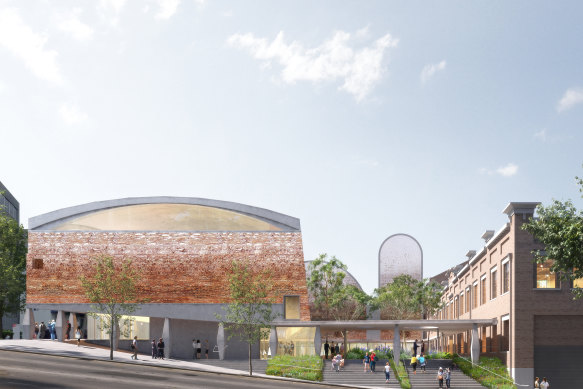Labor’s $300 million Powerhouse Ultimo revamp hit by last-minute hitch
By Linda Morris
Much of the modern wing of the Powerhouse Ultimo is to be pulled down and rebuilt after a last-minute problem emerged with the controversial $300 million museum redevelopment.
Construction giant Richard Crookes has been appointed to revamp the museum. Staircases, internal walls and mezzanines will be demolished within the heritage-listed Boiler House, Engine House, Power House and Turbine Hall, artisan studios built along Harris Street, and the building’s entrance reoriented to Haymarket and the CBD.

An artist’s impression of the revamped building and the galleria from Macarthur Street into the internal courtyard.Credit: Durbach Block Jaggers Architects
Under plans approved only two months ago, the upper steel structure of the Wran Building and Galleria, forming the modern wing of the Sulman Medal-winning architectural adaption to the 1988 museum, was to have been retained.
But it has now been deemed not strong enough to carry the new brick structure, and the steel-ribbed structure forming its galleria is to be replaced in the same scale and form, with a lower concrete structure kept in place to lessen the impact of construction works on the heritage Switch House.
Infrastructure NSW confirmed the late modification on Thursday, citing a series of concerns builders raised during the recent construction tender process. The existing steel structure was end-of-life and didn’t meet current building codes and standards.
“Modification 1 is not about changing the design of the approved heritage revitalisation of Powerhouse Ultimo, it’s about changing the methodology of building it,” a spokesperson said.
“The project remains on time and on budget, and a detailed construction program is currently being developed with Richard Crookes Constructions.”
Minister for Lands and Property Steve Kamper said the revitalisation would deliver the best and safest outcome for the museum and its passionate community of visitors.
“Importantly, the shape and scale of the iconic Wran and Galleria buildings will be safely replaced and future-proofed so they can be enjoyed by visitors and the community for decades to come,” he said.
“Keeping the structures is not only unsafe and non-compliant, it would cost the taxpayer more and give a limited warranty on the buildings, which isn’t justifiable given the end product will look the same.”

Former premier Neville Wran travelled by old steam train to announce the Powerhouse Ultimo venture in 1979.Credit: Fairfax
A second modification will remove an underground loading dock from the project to reduce risk to the foundations of the museum’s Switch House and save costs. Access will be retained through the neighbouring Harwood Building, which houses the museum’s offices.
The 1988 adaptive reuse of the more-than-century-old former Ultimo Power House to the Museum of Applied Arts and Science won many architectural and industry awards, including the Sir John Sulman Medal.
Architect Lionel Glendenning died in May still fighting the revitalisation project he believed would gut his Wran-era heritage masterpiece.
His widow and former deputy museum director Jennifer Sanders accused Labor of reducing its cultural jewel – the legacy of the late NSW Premier Neville Wran, who played a key role in the museum’s establishment – to three large voids and a ‘tin shed’ museum at unnecessary cost to taxpayers given the wing was less than 40 years old.
The late changes are permissible under exemptions to the precinct’s heritage listing, which requires the site to remain exclusively as a museum, preventing any potential sale or commercial development in the future, but allow for building modifications to the modern additions as long as its shape or form is not altered.
Former museum trustee Kylie Winkworth said these specific exemptions were “shockingly permissive”. “The whole museum as we know it is set for demolition and erasure. If there was genuine conservation of the Wran Building and Galleria to maintain its structural integrity as the minister promised, there would be no need to replace the steel structure.”
The Wran Building extension and light-filled Galleria were originally designed to serve as the entry hall, and parts were later converted to exhibition space. Existing glazing will now be replaced with cladding on the eastern facade of the Galleria.
Early construction works have already begun, and the government said it was on track for a construction completion date of late 2027 or early 2028.
A total of $256 million was committed to the project in this week’s NSW budget. The museum needs to raise a further $50 million in philanthropy.
Infrastructure NSW has been undertaking value engineering, a process that aims to find savings and improvements without compromising quality or performance.
The Ultimo museum was shuttered in February 2024 in the face of public protests ahead of the redevelopment. Some $15 million was set aside by government to move the collection objects from Ultimo to the museum’s Castle Hill storehouse.
Richard Crookes built Sydney Modern and was responsible for the award-winning restoration and refurbishment of the Walsh Bay finger wharves.
The Booklist is a weekly newsletter for book lovers from Jason Steger. Get it delivered every Friday.